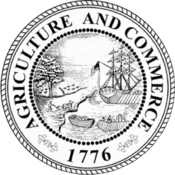Seal of Georgia
| Great Seal of the State of Georgia | |
|---|---|
 | |
| Versions | |
 Reverse | |
 Historical coat of arms (1876) | |
| Armiger | State of Georgia |
| Adopted | 1777 (original) 1914 (current) |
| Motto | State of Georgia, 1776 (obverse) Agriculture and Commerce, 1776 (reverse) |
The Great Seal of the State of Georgia is a device that has historically been used to authenticate government documents executed by the state of Georgia. The first great seal of the state was specified in the State Constitution of 1777, and its current form was adopted in 1914. Its specifications are currently spelled out by statute.
Description
The obverse (front) of the seal is centered on the coat of arms of the state: an arch with three columns, the arch symbolizing the state's Constitution and the columns representing the three branches of government (legislative, executive, and judicial). The words of the official state motto, "Wisdom, Justice, Moderation," are inscribed on scrolls that are wrapped around the columns. A man (possibly a soldier from the American Revolution) stands between the second and third columns, holding a drawn sword in his right hand, representing the military's defense of the Constitution. A border surrounds the coat of arms, and the motto "State of Georgia, 1776" is inscribed outside the arms.
The reverse (back) of the seal contains an image of Georgia's coast, with a ship (bearing the American flag) arriving to take aboard tobacco and cotton, symbolizing Georgia's export trade. A second, smaller boat represents the state's "internal traffic." Towards the left of the image, there is a man plowing and a flock of sheep. The motto "Agriculture and Commerce, 1776" is inscribed around the outside of the image.[1][2]
The dates listed on the obverse and reverse of the seal were originally 1799. The dates were changed by the Georgia state legislature in 1914 to reflect the date of the signing of the Declaration of Independence.[1]
History and lore

By law, the Secretary of State is the official custodian of the Great Seal, which is attached to official papers by executive order of the Governor. This custodianship has led to some controversies:
Period of the False Seal
- From 1868 to 1871, during the era of Reconstruction, the Great Seal was not used for state business. It had been hidden under the home of wartime Secretary of State Nathan C. Barnett, to prevent its use by Federal forces.[3] The Reconstruction government, having failed to locate the official seal, had a duplicate seal fabricated. The duplicate was a perfect match for the original, except for one small detail: the soldier held his sword in his left hand.[4] The era of Reconstruction government in Georgia became known as the "Period of the False Seal". In 1872, when Georgians re-took control of the government, Barnett (who had been re-elected by that point) unearthed the original seal and returned it to the Capitol.[3][5]
Three Governors controversy
- In December 1946, Governor-elect Eugene Talmadge died before assuming office. Talmadge's son, Herman, was appointed governor by the State Legislature. This was challenged by the Lieutenant Governor-elect Melvin Thompson, who maintained that the state constitution authorized him to assume the office upon the death of the governor. Outgoing governor Ellis Arnall announced that he would not relinquish the office until it was clear who the new governor was. The political turmoil that ensued became known as the "Three Governors Controversy". In January 1947, while all three governors occupied different portions of the State Capitol, Secretary of State Ben W. Fortson, Jr., took the seal and hid it.[3] This prevented any of the claimants to the governorship from executing any business until the Supreme Court of Georgia could make a ruling on the rightful winner. Thompson was eventually declared "acting governor" until a special election could be held to fill the remainder of the original term.[6] Herman Talmadge won the special election and served out the remaining portion of his father's term.
In 1902, the Georgia legislature mandated that the coat of arms (the central portion of the obverse) be included in the state flag of Georgia. Either the coat of arms or the state seal has appeared on every state flag since that date.[7][8]

A cast iron representation of the pillars and arch has stood at the north entrance of the University of Georgia since 1858. According to legend, it is bad luck for freshmen (or, in some versions, any undergraduate student) to walk under "The Arch", as the Athens landmark is popularly known. Legend suggests that any student walking through the arch prematurely will never graduate. Today, The Arch is an important symbol of the University.[9]
Government Seals of Georgia
-
Seal of the Georgia State Senate
-
Seal of the Georgia House of Representatives
-
Seal of the Supreme Court of Georgia
See also
References
- ^ a b "Georgia Secretary of State: State Seal". Secretary of State of the State of Georgia. Retrieved October 16, 2012.
- ^ State of Georgia (2012). "Official Code of the State of Georgia § 50-3-30". LexisNexis. Retrieved October 16, 2012.
- ^ a b c "Georgia Official and Statistical Register 1983-1984" (PDF). Department of Archives and History - A Division of Secretary of State. 1985. p. 252. Retrieved 2014-10-13.
- ^ http://files.usgwarchives.net/ga/baldwin/history/other/gms237historyo.txt
- ^ "Memory Hill Cemetery person information". Friendsofcems.org. Retrieved 2012-10-16.
- ^ "New Georgia Encyclopedia: Three Governors Controversy". Georgiaencyclopedia.org. 2002-12-08. Retrieved 2012-10-16.
- ^ "New Georgia Encyclopedia: State Flags of Georgia". Georgiaencyclopedia.org. Retrieved 2012-10-16.
- ^ "Georgia State Flag: c. 1906-1920". Digital Library of Georgia. Retrieved 2012-10-16.
- ^ "New Georgia Encyclopedia: University of Georgia". Georgiaencyclopedia.org. 2012-02-16. Retrieved 2012-10-16.




